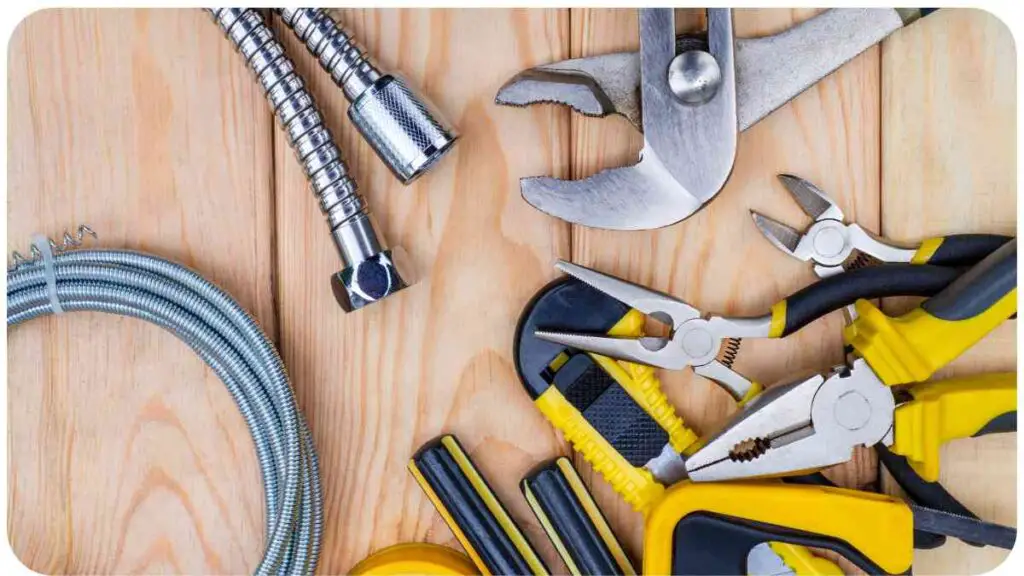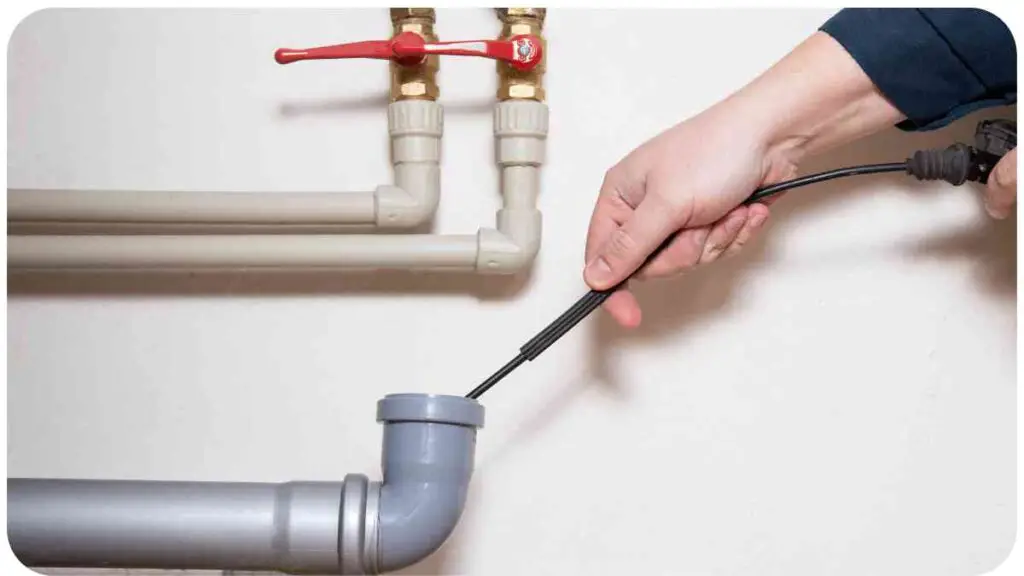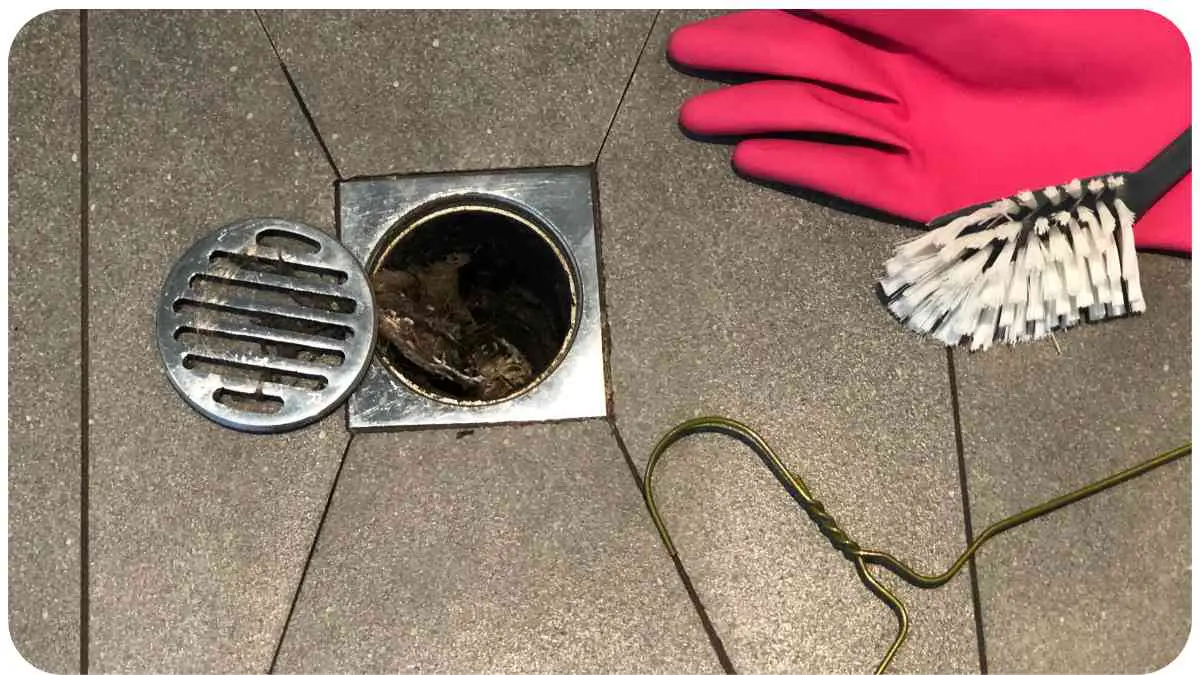Welcome to our step-by-step guide on how to unclog your shower drain. Dealing with a clogged shower drain can be a frustrating and inconvenient experience. Water pooling around your feet during a relaxing shower can quickly turn into a nuisance. This comprehensive guide will help you tackle shower drain clogs effectively and efficiently, enabling you to restore your shower’s functionality in no time.
In this article, we will cover various methods and techniques to unclog your shower drain, including natural solutions, chemical drain cleaners, and using a drain snake. We will also discuss preventive measures to avoid future clogs and the importance of professional assistance in more complex situations. So let’s dive in and get started!
| Takeaways |
|---|
| Unclogging Your Shower Drain: Tips for Success |
| – Regularly remove visible hair and debris to prevent clogs. |
| – Use natural solutions or chemical drain cleaners for stubborn clogs. |
| – Consider using a drain snake for deeper clogs. |
| – Flush the drain with hot water to clear any remaining debris. |
| – Install a drain cover or strainer to catch hair and larger debris. |
| – Avoid pouring oil, grease, or food particles down the drain. |
| – Seek professional help for persistent or complex clogs. |
| – Implement preventive measures to avoid future clogs. |
| – Know when to call a professional for assistance. |
| – Avoid common mistakes that can worsen the situation. |
2. Understanding the Causes of Shower Drain Clogs
Before we jump into the step-by-step guide to unclog your shower drain, let’s take a moment to understand the common causes of clogs. Identifying the source of the problem can help you prevent future blockages and select the most appropriate method for clearing your specific clog.
Building a support system after experiencing grief and loss can be difficult, but finding strength in the community can make a big difference. Check out our guide on building a support system after a loss to learn more about the benefits of the community during times of grief.
| Common Causes of Shower Drain Clogs |
| Hair buildup |
| Soap residue |
| Hard water mineral deposits |
| Foreign objects |
| Incorrect installation |
By recognizing these causes, you can take proactive measures to minimize the likelihood of a blockage occurring and ensure the long-term efficiency of your shower drain.
3. Tools and Materials Required

Before we begin the unclogging process, gather the following tools and materials:
| Tools and Materials |
| Plunger |
| Drain snake |
| Rubber gloves |
| Bucket |
| Baking soda |
| Vinegar |
| Hot water |
| Chemical drain cleaner (if needed) |
Having these items ready ensures a smoother and more successful unclogging endeavor.
Dealing with rusty screws in your bathtub overflow cover? Don’t worry, we’ve got you covered. Learn effective ways to fix rusty screws in a bathtub overflow cover and maintain your bathroom’s functionality.
4. Step 1: Preparing for the Unclogging Process
To start the unclogging process, it’s crucial to prepare the surroundings. Follow these steps:
- Clear the area around the shower drain. Remove any objects or loose debris that may obstruct the unclogging process.
- Put on a pair of rubber gloves to protect your hands from bacteria and potential irritants.
- Keep a bucket handy to collect any water that accumulates during the unclogging process.
Preparing yourself and the area will make the unclogging process more efficient and hygienic.
5. Step 2: Removing Hair and Visible Debris
Hair is one of the major culprits when it comes to shower drain clogs. Follow these steps to remove hair and visible debris:
- Start by using a pair of needle-nose pliers or tweezers to reach into the drain and pull out any visible hair or debris. Be cautious not to push the clog further down the drain.
- If the clog is located near the surface, you can also try using a bent wire hanger to hook onto the hair and pull it out.
- For more stubborn clogs, consider using a drain cover or strainer to catch hair and prevent it from entering the drain in the first place.
By removing hair and visible debris regularly, you can prevent clogs from forming and ensure your shower drain functions optimally.
Choosing the right drainage pipe for your driveway is crucial for proper water flow. Learn how to find the right drainage pipe to prevent issues like clogged shower drains and ensure efficient drainage.
| Type of Debris | Hair | Visible Debris |
| Removal Techniques | Needle-nose pliers | Tweezers |
| Bent wire hanger | Drain cover or strainer (preventive measure) |
6. Step 3: Using Natural Solutions to Clear Minor Clogs
If you’re dealing with a minor clog, you can try using natural solutions to dissolve it. Here’s how:
- Start by pouring about half a cup of baking soda down the drain.
- Follow it up with an equal amount of vinegar. The baking soda and vinegar will react and create a foaming action, which helps break down the clog.
- Allow the mixture to sit in the drain for around 30 minutes.
- After the waiting period, flush the drain with hot water to clear away the dissolved clog.
Using natural solutions is a cost-effective and eco-friendly approach to unclogging your shower drain. It’s particularly useful for smaller clogs caused by organic matter and soap residue.
| Natural Solutions | Baking soda + Vinegar |
| Waiting Time | 30 minutes |
| Additional Step (Flush with hot water) | Required |
7. Step 4: Applying Chemical Drain Cleaners for Stubborn Clogs
For more stubborn clogs that resist natural solutions, you may need to use chemical drain cleaners. Follow these steps carefully:
- Select a suitable chemical drain cleaner from a reputable brand. Ensure that it is compatible with your specific plumbing system.
- Read and follow the instructions provided by the manufacturer. Take note of any safety precautions and recommended waiting times.
- Carefully pour the recommended amount of drain cleaner into the shower drain.
- Allow the chemical solution to sit in the drain for the specified duration, as indicated in the instructions.
- Flush the drain thoroughly with hot water to remove the dissolved clog and any residue left by the drain cleaner.
Using chemical drain cleaners should be approached with caution. Be sure to wear rubber gloves and follow all safety instructions to protect yourself and your plumbing system.
Got a drain snake stuck in your pipes? Don’t panic! We’ve got you covered with easy steps to remove a stuck drain snake with ease and get your drains flowing smoothly again.
| Chemical Drain Cleaners | Brand |
| Safety Precautions | Rubber gloves |
| Recommended Waiting Time | As per manufacturer’s instructions |
| Additional Step (Flush with hot water) | Required |
8. Step 5: Snaking the Drain for Persistent Blockages

For particularly stubborn and persistent clogs, snaking the drain can be highly effective. Here’s how to do it:
- Insert the end of a drain snake into the shower drain until you feel resistance.
- Rotate the handle of the drain snake clockwise to break up the clog or grab onto it.
- Continue rotating and pushing the drain snake further into the drain until the clog is dislodged or removed.
- Slowly pull the drain snake back, ensuring that you don’t damage the pipes.
- Dispose of any debris or hair that may have been collected on the drain snake.
Snaking the drain is a more advanced technique that may require a bit of practice. If you’re unsure or uncomfortable doing it yourself, it’s advisable to seek professional assistance.
| Snaking the Drain | Drain snake |
| Technique Steps | Insert, Rotate, Push, Pull |
| Professional Assistance | Recommended |
9. Step 6: Flushing the Drain and Testing for Proper Flow
After unclogging your shower drain using the previous steps, it’s important to flush the drain and test for proper flow. Here’s what you should do:
- Run hot water through the drain for a few minutes to help clear any remaining debris and ensure smooth flow.
- Pay attention to the speed at which the water flows down the drain. If you notice any sluggishness or backups, there might still be a partial clog that requires further attention.
- If necessary, repeat the previous steps or consider seeking professional assistance if the issue persists.
Flushing the drain and testing for proper flow is a crucial step in ensuring that your shower drain is fully unclogged and functioning optimally.
| Flushing the Drain | Hot water flow |
| Testing for Proper Flow | Speed, Sluggishness, Backups |
| Additional Actions (if necessary) | Repeat previous steps, Seek professional help |
10. Preventive Measures to Avoid Future Clogs
Now that you’ve successfully unclogged your shower drain, it’s essential to take preventive measures to avoid future clogs. Here are some tips to keep in mind:
- Install a drain cover or strainer to catch hair and larger debris, preventing them from entering the drain and causing clogs.
- Clean the drain cover or strainer regularly to maintain its effectiveness.
- Avoid pouring oil, grease, or food particles down the drain, as they can solidify and create clogs.
- Use a hair trap or catch to prevent hair from going down the drain.
- Consider using a weekly or monthly natural cleaning solution, such as baking soda and vinegar, to help prevent buildup.
- Regularly remove any visible hair or debris from the drain surface.
By incorporating these preventive measures into your routine, you can significantly reduce the likelihood of future shower drain clogs.
| Preventive Measures |
| Drain cover or strainer |
| Regular cleaning |
| Avoid pouring oil or grease |
| Hair trap or catch |
| Natural cleaning solution |
| Regular maintenance |
11. Common Mistakes to Avoid
While unclogging your shower drain, it’s important to be aware of common mistakes that can worsen the situation. Avoiding these mistakes will help prevent any unintended damage or further clogs. Here are some common mistakes to steer clear of:
- Using excessive force: Applying too much force when using tools or snaking the drain can potentially damage the pipes. Be gentle yet persistent.
- Mixing different chemical drain cleaners: Combining different types of chemical drain cleaners can lead to hazardous reactions and harmful fumes. Stick to one type of cleaner at a time.
- Ignoring safety precautions: Always wear rubber gloves and protect your eyes when working with chemical drain cleaners or using a drain snake.
- Flushing with hot water before removing visible debris: Flushing without removing hair or debris near the surface can push the clog further down, making it more challenging to unclog.
- Neglecting regular maintenance: Regular cleaning and maintenance can prevent future clogs. Don’t wait for a severe blockage to occur before taking action.
By avoiding these mistakes, you can navigate the unclogging process more effectively and minimize the risk of further problems.
12. Significance of Professional Help
While DIY methods can be effective for minor clogs, certain situations may require professional assistance. It’s important to know when to seek help from a qualified plumber or drain cleaning specialist. Here are some instances where professional intervention becomes crucial:
- Persistent and recurring clogs despite various DIY methods.
- Slow drainage or complete blockage that affects multiple drains in the house.
- Unusual gurgling sounds or foul odors coming from the drains.
- Old or fragile plumbing systems that may be prone to damage during unclogging attempts.
- Limited knowledge or experience in plumbing, which can lead to potential mistakes or accidents.
Professional plumbers have the expertise, specialized tools, and knowledge to resolve complex clogs safely and efficiently. Knowing the limitations of your own capabilities and when to seek professional help is essential to avoid further complications.
13. DIY vs. Professional Drain Unclogging
Deciding whether to tackle a shower drain clog yourself or call for professional help depends on various factors such as the severity of the clog, your level of experience, and the available tools at your disposal. Here’s a comparison between DIY methods and professional drain unclogging:
DIY Drain Unclogging
- Pros:
- Cost-effective: DIY methods usually require common household items and natural solutions, saving you money on professional services.
- Convenience: You can address minor clogs promptly without having to wait for a professional or schedule an appointment.
- Learning opportunity: Trying DIY methods can provide you with practical knowledge and skills for handling future clogs.
- Cons:
- Limited effectiveness: DIY methods may not be sufficient for severe or recurring clogs, leading to frustrations and potential damage.
- Potential mistakes: Lack of experience or improper technique can worsen the clog or cause damage to the plumbing system.
- Time-consuming: Unclogging may take longer if you’re experimenting with different methods or struggling to dislodge stubborn clogs.
Professional Drain Unclogging
- Pros:
- Expertise and experience: Professionals have the knowledge, specialized tools, and techniques to handle even the most challenging clogs effectively.
- Targeted solutions: Professionals can accurately diagnose the cause of the clog and provide appropriate solutions.
- Time-saving: Professionals can quickly resolve the clog, restoring the proper functioning of your shower drain without wasting your time.
- Cons:
- Cost: Professional drain unclogging services come at a cost, which can vary depending on the complexity of the clog and the location.
- Scheduling: You may need to wait for an appointment, especially during busy periods, before the issue can be addressed.
- Lack of control: You won’t have direct involvement in the unclogging process, relying on the expertise of the professional.
Consider the severity and frequency of your clogs, your comfort level with DIY methods, and the potential risks involved before deciding whether to handle the unclogging yourself or seek professional assistance.
14. Frequently Asked Questions (FAQs)
Q1: Can I use a plunger to unclog my shower drain?
A1: Yes, a plunger can be effective for unclogging a shower drain. Ensure there is enough water in the shower to cover the rubber part of the plunger. Create a tight seal around the drain and vigorously plunge up and down several times to dislodge the clog.
Q2: What should I do if none of the DIY methods work?
A2: If DIY methods don’t clear the clog, it’s recommended to seek professional help. A plumber can assess the situation, utilize specialized tools, and provide targeted solutions to resolve the issue.
Q3: How can I prevent future clogs in my shower drain?
A3: To prevent future clogs, consider installing a drain cover or strainer to catch hair and debris. Regularly clean the drain cover and remove visible hair or debris. Avoid pouring oil, grease, or food particles down the drain, and use a hair trap or catch to prevent hair from entering the drain.
Q4: Are chemical drain cleaners safe to use?
A4: Chemical drain cleaners can be effective, but they should be used with caution. Follow the manufacturer’s instructions, wear appropriate protective gear, and never mix different drain cleaners. Keep in mind that repeated use of chemical drain cleaners can potentially damage your plumbing system.
Q5: When should I call a professional for drain unclogging?
A5: It’s recommended to call a professional if you’re dealing with persistent and recurring clogs, slow drainage affecting multiple drains, unusual sounds or odors, or if you lack the knowledge and experience to resolve the issue yourself.
15. Conclusion
Dealing with a clogged shower drain can be frustrating, but armed with the right knowledge and tools, you can successfully unclog it yourself in many cases. Start by removing visible hair and debris, and then try natural solutions or chemical drain cleaners for stubborn clogs. If necessary, use a drain snake and flush the drain with hot water. Remember to implement preventive measures to avoid future clogs.
However, if DIY methods fail or you’re dealing with more complex issues, don’t hesitate to seek professional assistance. Plumbers have the expertise to tackle even the toughest clogs and ensure the long-term efficiency of your shower drain. By taking the appropriate steps and knowing when to ask for help, you’ll be able to keep your shower drain flowing smoothly for years to come.
Further Reading
Here are some additional resources that provide more detailed information on how to unclog a shower drain:
- ShowerAddict.com: How to Unclog a Shower Drain – A Step-by-Step Guide: This comprehensive guide offers a step-by-step approach with detailed instructions and visuals to help you effectively unclog your shower drain.
- BobVila.com: How to Unclog a Shower Drain: Bob Vila provides useful tips and techniques to clear shower drain clogs, including natural remedies, DIY methods, and when to seek professional help.
- ArchitecturalDigest.com: How to Unclog Shower Drain: This article discusses various causes of shower drain clogs and provides insights into preventive measures along with step-by-step instructions for clearing clogs.
Note: It’s always important to cross-reference information from multiple sources and apply methods that are appropriate for your specific situation.
FAQs
Q: How often should I clean my shower drain to prevent clogs?
A: It’s a good practice to clean your shower drain regularly, removing visible hair and debris to prevent clogs from forming. The frequency may vary depending on the amount of hair and usage, but once a month is generally recommended.
Q: Can I use bleach to unclog a shower drain?
A: While bleach can help remove certain substances and disinfect the drain, it may not be effective for clearing clogs. It’s better suited for maintenance and sanitization rather than unclogging purposes.
Q: Is it safe to use boiling water to unclog a shower drain?
A: Boiling water can be effective for loosening minor clogs caused by soap residue or organic matter. However, avoid using boiling water if you have PVC pipes, as the heat may damage them. Use hot water instead.
Q: What tools do I need to unclog a shower drain?
A: Depending on the severity of the clog, you may need needle-nose pliers, tweezers, a bent wire hanger, a drain snake, or a plunger. These tools can assist in removing hair and dislodging clogs.
Q: Can tree roots cause a shower drain clog?
A: In most cases, tree roots are not a direct cause of shower drain clogs, as they primarily target sewer lines. However, if there are root intrusions in the main sewer line, it can eventually lead to drainage issues in various plumbing fixtures, including showers.
Remember, if DIY methods don’t resolve the issue or you’re uncertain, it’s advisable to seek professional assistance to prevent further complications.

Hellen James is the author of the blog and a licensed plumber with over 15 years of experience. She shares her knowledge and experience in plumbing and drainage through insightful and informative articles

